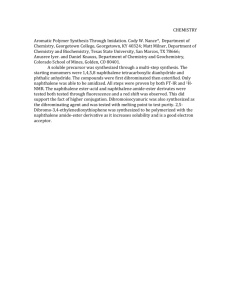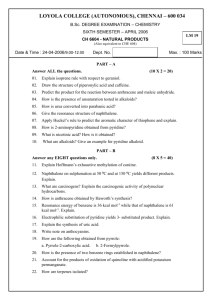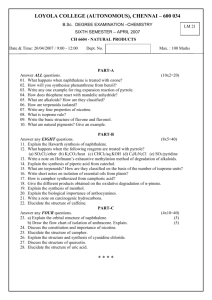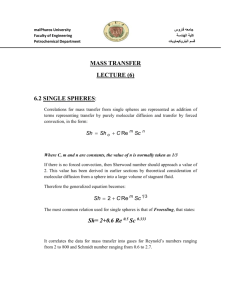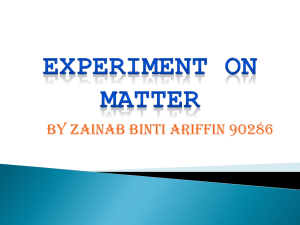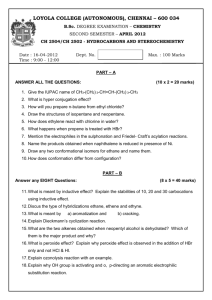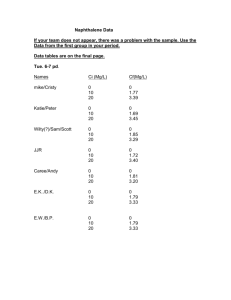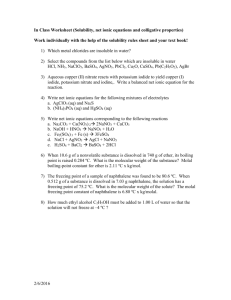A&WMA Symposium on Air Quality Measurement Methods and Technology, April... San Francisco, CA
advertisement
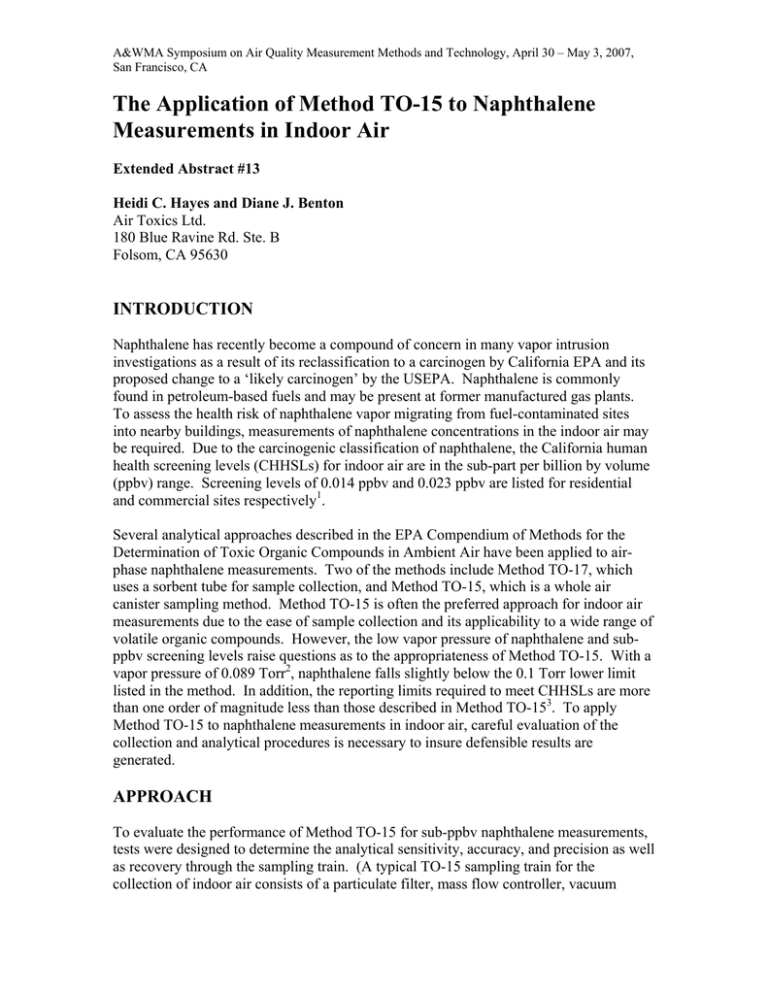
A&WMA Symposium on Air Quality Measurement Methods and Technology, April 30 – May 3, 2007, San Francisco, CA The Application of Method TO-15 to Naphthalene Measurements in Indoor Air Extended Abstract #13 Heidi C. Hayes and Diane J. Benton Air Toxics Ltd. 180 Blue Ravine Rd. Ste. B Folsom, CA 95630 INTRODUCTION Naphthalene has recently become a compound of concern in many vapor intrusion investigations as a result of its reclassification to a carcinogen by California EPA and its proposed change to a ‘likely carcinogen’ by the USEPA. Naphthalene is commonly found in petroleum-based fuels and may be present at former manufactured gas plants. To assess the health risk of naphthalene vapor migrating from fuel-contaminated sites into nearby buildings, measurements of naphthalene concentrations in the indoor air may be required. Due to the carcinogenic classification of naphthalene, the California human health screening levels (CHHSLs) for indoor air are in the sub-part per billion by volume (ppbv) range. Screening levels of 0.014 ppbv and 0.023 ppbv are listed for residential and commercial sites respectively1. Several analytical approaches described in the EPA Compendium of Methods for the Determination of Toxic Organic Compounds in Ambient Air have been applied to airphase naphthalene measurements. Two of the methods include Method TO-17, which uses a sorbent tube for sample collection, and Method TO-15, which is a whole air canister sampling method. Method TO-15 is often the preferred approach for indoor air measurements due to the ease of sample collection and its applicability to a wide range of volatile organic compounds. However, the low vapor pressure of naphthalene and subppbv screening levels raise questions as to the appropriateness of Method TO-15. With a vapor pressure of 0.089 Torr2, naphthalene falls slightly below the 0.1 Torr lower limit listed in the method. In addition, the reporting limits required to meet CHHSLs are more than one order of magnitude less than those described in Method TO-153. To apply Method TO-15 to naphthalene measurements in indoor air, careful evaluation of the collection and analytical procedures is necessary to insure defensible results are generated. APPROACH To evaluate the performance of Method TO-15 for sub-ppbv naphthalene measurements, tests were designed to determine the analytical sensitivity, accuracy, and precision as well as recovery through the sampling train. (A typical TO-15 sampling train for the collection of indoor air consists of a particulate filter, mass flow controller, vacuum A&WMA Symposium on Air Quality Measurement Methods and Technology, April 30 – May 3, 2007, San Francisco, CA gauge, and a SUMMA-polished or fused-silica-lined collection canister.) Vapor-phase working standards were prepared in 6 liter SUMMA canisters using 100 ppbv NIST traceable standards purchased from Scott Specialty Gases. Dynamic dilution techniques using a commercially available dilution system resulted in poor precision for naphthalene. As a result, static dilution techniques were used to generate working standards at 0.10 ppbv and 2.0 ppbv. To simulate the expected relative humidity (RH) present in a typical indoor air environment, the working standards were prepared at approximately 40% RH. Toluene was spiked at the same concentration relative to naphthalene in each working standard as a reference compound. Analytical results were generated using an Agilent 6890 GC coupled with a 5975 mass spectrometer. Selected Ion Monitoring (SIM) data was used for the all of the tests. The air concentrator was an in-house design using a hydrophobic multisorbent trap and a cryogenically cooled glass bead trap. The maximum load volume for the analytical system was 500 milliliters. All canisters and sampling trains were certified as clean before use. Analytical Performance Initial Calibration To evaluate the analytical performance of sub-ppbv levels of naphthalene, a 6-point calibration curve was generated from 0.010 ppbv to 2.0 ppbv. Each point was analyzed in duplicate. The relative response factors (RRF) generated from the calibration curve are summarized in Table 1. Both naphthalene and toluene met the method acceptance limit of <30% RSD for the calibration curve and <25% RPD for duplicate analysis. Similar performance was observed for both naphthalene and toluene. Table 1. Relative Response Factors Concentration (ppbv) 0.010 0.020 0.10 0.20 1.0 2.0 Average RRF %RSD RRF-1 1.436 1.070 0.900 1.228 1.234 1.241 1.185 15% Toluene RRF-2 1.502 1.051 0.927 1.169 1.194 1.387 1.205 18% %RPD 4.5% 1.8% 2.9% 4.9% 3.3% 11% 1.7% Naphthalene RRF-1 RRF-2 1.229 1.327 1.254 1.352 1.178 1.190 0.901 0.737 0.882 1.018 1.186 1.286 1.105 1.152 15% 21% %RPD 7.7% 7.6% 1.0% 20% 14% 8.1% 4.2% Sensitivity The analytical response for the 0.010 ppbv naphthalene standard was strong and well above any visible baseline noise. The quantitation ion peak (mass 128) for 0.010 ppbv naphthalene is shown in Figure 1. A&WMA Symposium on Air Quality Measurement Methods and Technology, April 30 – May 3, 2007, San Francisco, CA Figure 1. Naphthalene extracted ion peak at 0.010 ppbv Carryover When measuring sub-ppbv levels, maintaining a clean analytical system is critical for reporting accurate results. A major source of contamination can be a result of carryover of target compounds from the previous sample. To assess the potential carryover of naphthalene, a 2.0 ppbv standard analysis was followed by the analysis of three humidified laboratory blanks. Between each run, the sample introduction line (PEEK tubing) was flushed for at least 15 minutes with zero air at 50 mL/min. The results of each run are shown in Figure 2. The laboratory blank analyzed immediately after the 2.0 ppbv standard yielded a carryover concentration of 0.063 ppbv for naphthalene while toluene was below 0.010 ppbv. While the second and third laboratory blank continued to show a decrease in carryover concentration, naphthalene was still above 0.010 ppbv in both runs. This data suggests that carryover of naphthalene from sample to sample could be a significant concern relative to other VOCs such as toluene. Figure 2. Carryover Results 10 Standard (2 ppbv) Naphthalene Toluene 1 ppbv Blank-1 0.1 Blank-2 Blank-3 0.01 0.001 Daily Continuing Calibration Recovery As the naphthalene tests were conducted, continuing calibration verification (CCV) standards were analyzed over a 7-day period. The same 0.10 ppbv working standard used for initial calibration was analyzed as the CCV. The daily CCV recovery for naphthalene A&WMA Symposium on Air Quality Measurement Methods and Technology, April 30 – May 3, 2007, San Francisco, CA and toluene relative to the initial calibration 0.10 ppbv relative response factor is summarized in Figure 3. While toluene recovery was consistent, ranging from 87% to 103%, naphthalene recovery showed significantly more drift over the same 7-day period. By day 7, naphthalene was already outside of method acceptance limits of 70-130%. More investigation is required to determine the cause of this drift. Figure 3. Trend in CCV recovery 180% Recovery 160% 140% 120% 100% 80% 60% Naphthalene 40% 20% Toluene 0% 0 3 4 5 6 7 Day Sample Train Recovery Test Compounds with lower vapor pressures have a greater tendency to adsorb to surfaces than to remain in the vapor state. While naphthalene has been successfully recovered at ppbv concentrations from SUMMA-polished canisters over a 30-day period4, recovery of sub-ppbv levels through the entire indoor air sampling train has not been evaluated. To measure sample train recovery, a 0.10 ppbv naphthalene standard was prepared at 40%RH in a 15 liter SUMMA canister and attached to 3-way fitting. Three sampling trains, each consisting of a 2 micron particulate filter, mass flow controller, vacuum gauge, and 6 liter canister, were attached to the 0.10 ppbv fill standard using Teflon® tubing. A total of four sets of three trains were tested. Two sets of sampling trains used fused-silica-lined (FSL) flow controllers and FSL canisters, and two sets used standard flow controllers and SUMMA canisters. The flow controllers for each sampling train were set at various flow rates. Because the fill standard was pressurized, flow through each flow controller was not constant with higher flow rates observed early in the sampling event. Approximate flows tested for each set of trains ranged from 5 mL/min to 80 mL/min. The results of the tests are summarized in Table 2. A&WMA Symposium on Air Quality Measurement Methods and Technology, April 30 – May 3, 2007, San Francisco, CA Table 2. Naphthalene recovery through sampling trains Type SUMMA SUMMA FSL FSL Train 1 (%R) 90 77 107 89 Train 2 (%R) 86 81 102 75 Train 3 (%R) 95 82 102 80 Average (%R) 90 80 104 81 The data indicates that sub-ppbv naphthalene recovery through sampling trains is acceptable for both standard SUMMA trains and FSL trains. Recovery is also consistent regardless of the flow rates sampled through each train. CONCLUSIONS Despite its low vapor pressure, the data suggests that Method TO-15 can be successfully applied to sub-ppbv concentrations of naphthalene in indoor air. Naphthalene performed as well as toluene in terms of precision and linearity of the calibration curve. Sensitivity at 0.010 ppbv concentration was easily achieved using a standard TO-15 analytical system in the SIM mode. In addition, naphthalene demonstrated acceptable recovery through both FSL and SUMMA sampling trains. Based on this study, several challenges exist for the laboratory when adding naphthalene to the list of TO-15 target analytes at sub-ppbv levels. Carryover of naphthalene in the TO-15 system appears to be a significant concern relative to other compounds with higher vapor pressure. Additionally, daily variability of naphthalene recovery appears to be greater than standard TO-15 compounds. Finally, as an observation during this study, the preparation of accurate ppbv-level working standards was a significant challenge. Without proper validation of preparation techniques, both primary and secondary sources may exhibit a bias and generate inaccurate results. REFERENCES 1. Use of California Human Health Screening Levels (CHHSLs) in Evaluation of Contaminated Properties, California EPA, January 2005. See http://www.calepa.ca.gov/Brownfields/documents/2005/CHHSLsGuide.pdf 2. CRC Handbook of Chemistry and Physics, 70th edition, Weast, Robert C, ed. Boca Raton, FL: CRC Press Inc. p. D-214-216. 3. Compendium of Methods for the Determination of Toxic Organic Compounds in Ambient Air: Method TO-15, Second Edition, U.S. Environmental Protection Agency: Research Triangle Park, NC, January 1999; EPA 600/625/R-96/010b. A&WMA Symposium on Air Quality Measurement Methods and Technology, April 30 – May 3, 2007, San Francisco, CA 4. Brymer, D.A.; Ogle, L.D.; Jones, C.J. and Lewis, D.L. “Viability of Using SUMMA Polished Canisters for the Collection and Storage of Parts per Billion by Volume Level Volatile Organics.” Environ. Sci. Technol., 30, 188-195, 1996.
